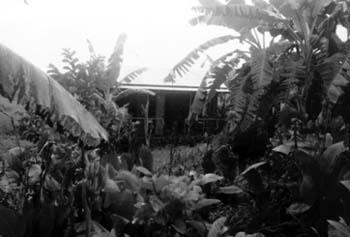I am frightened by the jungle. I am frightened by the sickly sweet odors, by the moist darkness, by the dank fecundity. I am frightened by the chaos: green things lash about in slow motion, choke off lesser plants, rise towards the sun like those subconscious horrors that sometimes bubble up into the conscious mind. (Jaguars Ripped My Flesh 42-43)He is writing about the rainforest of Northern Amazonia, more specifically the "Mundo Perdido" that straddles Venezuela and Guyana, and a clearer instance of Latin America as the West's unconscious would be hard to find.
[UPDATE: OK, I've found one.]
Nor could one hope for a better example of the way in which the unconscious is cast in terms of (feminine) sexuality (and vice versa, of course): "sickly sweet odors," "moist darkness," "dank fecundity." Not that there is anything very unconscious about these associations for Cahill. A little later, in a shallow canyon high up on Mount Roraima, the plateau mountain that inspired Arthur Conan Doyle's The Lost World, he strips off his clothes and, standing "naked under the unfamiliar sun," informs us that "it seemed to me that the smooth, rounded, dripping rocks, the puddled depressions, the archways and spires, all had overtly sexual connotations." What follows is a patch of rather purple prose that ends with "a terrible roar of release" as water from the plateau cascades down the mountainside (56).
It is often suggested that psychoanalysis is complicit with the colonial imagination. But although (as a good Deleuzian) I'm skeptical of many aspects of Freud's work, it can also obviously be invoked to analyze and criticize colonialism's own fantasies and desires.
The thing about the unconscious is that it is at the same time both alien and strangely familiar, intimate: unheimlich. What is frightening about the unconscious is also what is frightening about the self.
Cahill admits that the Latin American landscape (its populace, too, while we're at it) functions for him as a kind of Rorschach blot: "there was a cavernlike quality to the canyon, and the mind does not allow such shapes to go uninterpreted" (55). But it is not as though such projections are "merely" imaginary. Or rather, the point is that they have real effects. As Cahill says of Conan Doyle's story, "his fantasy [. . .] was so compelling that it gave the area its name" (44). Moreover, Conan Doyle's fantasy motivates Cahill's own trip to the region, otherwise a wholly senseless enterprise, particularly at the time of year he is there:
The urge to climb Mount Roraima in the rainy season is simply inexplicable without reference to psychiatric literature--and the tales of adventure one reads in childhood. (45)The notion that the tropics drive unwary travelers mad is a familiar one; but so is the idea that they must be a little unhinged to be there in the first place.
And Cahill finds a fair few other foreigners who have either been adversely affected by this particular heart of darkness, or who were some way round the bend already. Not least the Latvian "hermit" Laime who "for nineteen years [. . .] had lived alone in the jungle, nineteen years alone with his thoughts" (48). But the prime example is Cahill, who is introduced as an anonymous third person, as though unrecognizable even to the author himself: "the gringo was sweating in the humid heat, and he began babbling in incoherent Spanish. [. . .] the big one with the beard, he was a writer named Tim Cahill" (40, 41).
The tropics, as so often, are a place where men (less often women) go to find themselves, to find the truth of the stories they heard as children, to find and confront their culture's primal fears. But they are also a place where outsiders too easily lose themselves, either figuratively or literally. The last person who had tried to climb the mountain in the rainy season was "a solitary hiker from Caracas who had supposedly died in the frigid rains there" (53). And Cahill and his friends dice with death at least twice, at the outset when they are stopped by a Venezuelan army patrol ("'They almost shot us,' I said, incredulous" [41]), and at the end when the pilot due to fly them back over Roraima crashes his plane on the way down to meet them.
Cahill ends his account with an image of the dead at Jonestown, whose story he had covered some years previously, and so an image of "all those bodies bloating in the heat and the rain" (59). The tragic end to the People's Temple saga, a tale of misplaced faith and mass suicide, comes to represent all the fears of what Latin America will bring out in us.

No comments:
Post a Comment